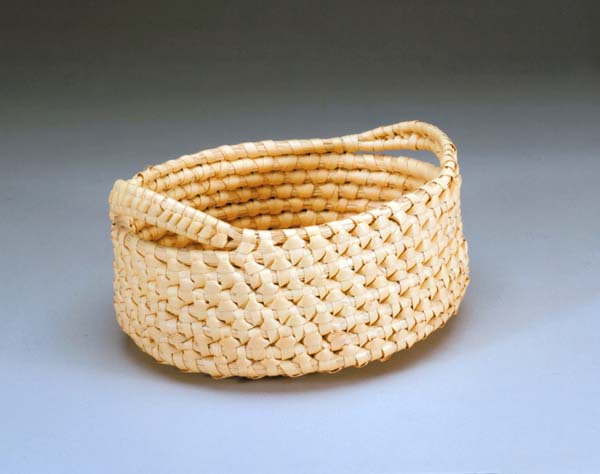Houma Nation
In the eighteenth century Houma people established trade and political relationships with French and Spanish colonists. In the twentieth century Houmas unified their community and successfully struggled for political recognition.
This entry is 6th Grade level View Full Entry

NEW ORLEANS MUSEUM OF ART
Palmetto leaf basket with handles created by master basket weaver Janie Verret Luster of the United Houma Nation.
In 1682, when French explorer René-Robert Cavelier, sieur de La Salle, journeyed down the Mississippi River, he heard rumors that the Houmas lived on the eastern banks near present-day West Feliciana Parish. Although his journal entries provide the first written documentation of the Houmas, the tribe did not come into direct contact with Europeans until 1686, when explorer Henri de Tonti passed through its village. In the eighteenth century the Houmas—a small, Muskogean-speaking, agricultural people—established important trade and political relationships with French and Spanish colonists.
How did Houma people interact with European traders and colonists?
As European colonists expanded westward, their traders moved further into the continent’s interior. To obtain goods, enslave Indigenous people, and intimidate enemy nations, these traders and their Native allies conducted violent raids along the Mississippi River that caused many Indigenous nations located in the region to flee.
As a result of these frequent raids, the Tunicas—historically located to the north of the Houmas—moved south and settled in Houma territory. In 1706 tensions between the two tribes flared, and the Tunicas attacked their hosts. The surviving Houmas fled downriver in search of safer living arrangements and chose to relocate closer to French colonists. Settling on the fertile lands north of Lake Pontchartrain, along the Mississippi River, and across from Point Coupee Parish, the Houmas raised corn, beans, hens, and other foodstuffs that they brought into New Orleans to trade. By the 1720s the Houmas were active participants in Louisiana’s colonial economy, building strong trade and military alliances with the French.
Compared to other tribes the Houmas were few in number. Pierre Le Moyne, sieur d’Iberville, recorded their population at 350 men in 1699, a number far below what it was before the spread of disease and war brought on by European colonists. Extremely important to the survival of the early Louisiana colonists, small Native nations supplied French settlers with food and material goods during shortages. Throughout the French colonial period, the Houmas also regularly acted as scouts and supported the French during military conflicts with other American Indian nations.
How did the French and Indian War affect the Houmas?
Historical documents from this period show that during the 1730s, the Houma were split into two villages: one on the eastern and another on the western bank of the Mississippi River. These two Houma groups remained separated until the 1760s, when they reunited on the western side of the river.
This reunion happened, at least in part, because of the French and Indian War (1754–1863), which was part of the global Seven Years’ War. Once they won the war, the British and their Native allies gained a sizable amount of territory in North America. As part of the peace agreements in the Treaty of Paris, signed on February 10, 1763, the French King transferred all of France’s land holdings east of the Mississippi, except New Orleans, to the British Crown. In addition France gave its wartime ally, Spain, the western half of the Louisiana territory, including New Orleans, in the secret Treaty of Fontainebleau a year before the war ended.
These transfers took place, however, without the knowledge or consent of the Native nations living within the territories. Upset by the territorial transfer, the loss of alliances with the French, and the changes in colonial leadership, several tribes, including the Houmas, responded by forging new relationships and relocating to areas of Spanish control. The Houmas who lived on the eastern bank of the Mississippi, for instance, crossed west into what is now Ascension Parish in 1763 to avoid living in British territory. Presumably they believed their community would fare better in Spanish Louisiana.
In 1769 Spanish governor Alejandro O’Reilly invited the chief of the Houmas to New Orleans to participate in a ceremony affirming the tribe’s loyalty to the Spanish empire. As a symbol of the alliance, O’Reilly gave the chief a medal and some small gifts.
How does the Houma culture survive today?
Throughout the eighteenth century the Houmas continued to trade with colonial settlers, enslaved people, and other Native nations. They relied on seasonal production practices—farming, planting, hunting, fishing, and raising chickens—during the warm months of the year and then moved to the outskirts of New Orleans to market these goods during the winter months.
Today—generations after resettling southward and some intermarriage with Acadians in South Louisiana—the Houmas are regarded as keepers of Louisiana French, as the language is dying out across the rest of Cajun country. Historian Carl Brasseaux has noted: “The 1990 census indicated that approximately sixty percent of the Houma residing in Terrebonne Parish and almost fifty percent of the Lafourche Parish Houma over five years of age spoke Cajun French as their first language.”
In the twentieth century the Houmas struggled for political recognition. After facing racial discrimination and educational disadvantages in the first half of the century, the Houmas in Terrebonne and Lafourche Parishes strove to unify their community. The state of Louisiana officially recognized the United Houma Nation in 1977. Currently the Houma community claims approximately 17,000 members and continues to keep Native traditions alive, proudly asserting their identity.
